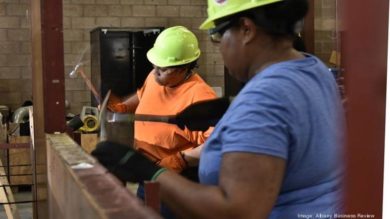Laquasia Douglas, Charisma Santos and Natasha Tissiera are survivors.
They’re still enrolled in a six-week pre-apprentice program for carpenters that was created to get more women, especially minorities, into a field that historically has been dominated by white men.
Four other women dropped out of the program in Albany after the first week.
One left because she’s allergic to dirt and pollen and didn’t want to get dirty.
Douglas, Tissiera and Santos are determined to finish.
“I’m not a quitter,” said Santos, 32, a single mother raising four children in Troy. “Anything that I started, I finish. I like to challenge myself.”
So few non-whites work in construction that to have three black women make it to the third week of the program is considered a success by the Northeast Regional Council of Carpenters.
The numbers illustrate just how difficult it is attract and retain women and minorities despite efforts over the years by the industry and state and federal governments to raise awareness about career opportunities and lower the barriers to entry.
Just 2.6 percent of the 7.82 million construction and extraction workers in the U.S. are women, according to “Women in Construction: Still Breaking Ground,” a report released in 2014 by the National Women’s Law Center.
The percentage is about the same as it was 30 years ago.
White, non-Hispanic women make up the largest share, 2 percent. That’s followed by Hispanics, 0.4 percent, and blacks, 0.2 percent.
Although women are now well-represented in many professions, construction remains an outlier for various reasons: lack of interest or encouragement for young women to get involved; hostility and harassment from men in the field; unfamiliarity with apprenticeships; and insufficient skills to succeed if they enroll.
Of course, it’s not just women who are turned off by construction. Many young men, regardless of race, have no interest in the field. In high school, they are typically urged to attend college, not learn a trade. Many lost their jobs during the last recession and never returned.
Nearly 150,000 construction jobs are vacant in the nation today, almost twice as many as five years ago, according to the Bureau of Labor Statistics.
“I believe our average age in the carpenter’s union is about 47, 48 years old,” said Sue Schultz, chair of the Northeast Regional Council of Carpenters Sisters in the Brotherhood program. “In another 10 years, there could be quite a few people retiring. We have to make sure we fulfill the needs of contractors out there for a trained workforce.”
The jobs pay well. A first-year carpenter apprentice in the Albany region earns $15.81 per hour in wages and $10.62 in benefits. A journey carpenter earns $30.38 per hour in wages and $20.30 in benefits.
“In today’s society, you’ve got people from all walks of life,” said Michael Shanahan, president of Local 291. “Everybody needs a career.”
The Northeast Regional Council of Carpenters last year started a pre-apprentice program in north and central New Jersey on behalf of the United Brotherhood of Carpenters. The goal: increase the percentage of female carpenter apprentices in the state from 2 percent to 10 percent in five years.
“We’ll make it in New Jersey,” Schultz said.
Upstate New York is another target area.
Here’s how it works: the union spreads the word about the pre-apprentice program online, in community meetings and through other venues. To qualify, applicants must be 18 or older; have a high school diploma or equivalency degree; be physically able to work; have reliable transportation; and pass a drug test.
Those accepted into the six-week program are not paid during the training, but given tools and work boots worth about $450, plus a $50 weekly gas card. They attend Monday to Friday, 8 a.m. to 4:30 p.m. They get hands-on instruction, classroom training and field experience.
Successful completion gives them an advantage over someone who walks into a union hall without any training and tries to become an apprentice. The apprentice slots are competitive, with selections based on a ranking system. Performance on a math test, an interview and other factors determine an individual’s ranking.
Six women started the pre-apprentice program last year in Albany. Four finished. Three of the four became apprentices, said David Moak, training coordinator at Northeast Regional Council of Carpenters. The fourth went into the military.
Even though just three have survived the training so far this year, Moak is encouraged by what he sees.
“This program has opened the door to a lot of women who never had a chance,” he said.
Moak been a carpenter for 33 years, the last 18 in charge of training. He’s a patient, easy-going guy who clearly enjoys teaching. He’s also thrilled to have considerably more space for students to build mock-ups because of a big investment the union made last year.
The union paid $3.65 million for two 30,000-square-foot buildings at 14-16 Corporate Circle, an office park off New Karner Road. One building will serve as administrative offices. The other is the training center for all apprentices.
On a recent day, Douglas, Santos and Tissiera were learning how to assemble concrete forms using rectangular panels held together by metal pins. Each wore a tool belt, boots and hard hat. They listened intently to their instructor, Candice Gasson. She has been in the union for 16 years and is a role model for the women.
“It’s my job to be tough on them but let them know this is the job we’re doing,” Gasson said. “It’s not for every woman, or man.”
Nearby, 16 apprentices — all of them white men — were erecting metal studs. The apprentices have one to four years of job experience. Apprentices must attend four weeks of unpaid training annually to improve their skills.
There are 249 apprentices in the carpenters’ union. Just 13 are women; 11 are white. One is Deidre Farr, a 34-year-old single mother from Rome starting her second year as an apprentice. Her previous jobs were as a cashier and at the post office. She didn’t go through the pre-apprentice program, but was able to pass the entry test.
“Every job that I’ve gone on, I loved,” Farr said. “I was there with open arms, and they taught me.”
Pre-apprentice construction trade programs for women are rare in the Albany area. The electricians’ union this year started one that’s also open to minority men and military veterans. Of the nine who are about to finish 300 hours of training, three are women, including one minority.
Six of the nine have already been accepted as electrician apprentices, said Rick Cataldo, training director at the Tri-City Joint Apprenticeship Training Committee.
The new programs are creating more opportunities in the industry, said Eileen Venn, local chapter president of National Association of Women in Construction.
“It opens the door to let them do it without saying, ‘I’m fully 100 percent committed,’” Venn said. “They don’t have to make the investment in the tools before they just walk into the union hall blind, which can be very intimidating. It’s very important for all of them to have pre-apprentice training.”
Laquasia Douglas
Age: 27
Resides: Albany
Family: Single, no children
Previous job: University at Albany cook
Why she enrolled in the program: Douglas worked at UAlbany for five years before losing her job. She then got her GED and wanted to learn a trade at the Educational Opportunity Center. “I saw all the guys in there making all these beautiful things and I thought maybe I could do that.”
How the training has gone so far: “So far it’s good. It’s very challenging but you’ve got to push yourself through that challenge. They gave us everything we needed. All I had to do was bring my body here. They even provided us with gas.”
Why she will finish the training: “I just feel like right about now I can make it through anything as long as I believe in myself. The other women here give us that courage.”
Charisma Santos
Age: 32
Resides: Troy
Family: Single with four children aged 2 to 15
Previous job: Peer advocate at YWCA
Why she enrolled in the program: Santos bought her first home through a foreclosure sale and has been renovating the interior. “We had to do the framing all over again. I like the fact every day I’m doing something different. I like to see what I have done instead of doing the same thing every day.”
Were you also interested because of the better pay and benefits? “Yes, it was more of a career than a job. I was tired of working at just a job. For me and my kids I’ve got to provide and support them as well.”
Why she will finish the training: “I’m not a quitter. Anything that I feel like I started, I finish. I like to challenge myself.”
Natasha Tissiera
Age: 36
Resides: Watervliet
Family: Married with two step-children and one child
Previous jobs: Cashier, postal service, health care
Why she enrolled in the program: “The health care field is nice but it’s not what I wanted. I wanted to be hands-on. I was a medical assistant, did patient registration, worked customer service at an insurance company.”
How the training has gone so far: “I’m not going to lie. It’s what it is. It’s construction. It’s hard. It’s strenuous. You have to know your math. You have to be quick. It keeps you busy. I’m always learning. It’s different every day. When I come in I don’t know what I’m going to do.”
Why she will finish the training: “When you hit the pavement and you’re down and out and you have that hunger to do more and more, it’s your drive that carries you. It’s not what’s going to be in your pocket. It’s the drive of wanting to know and wanting to learn. Each day I go home tired but I wake up wanting to come here.”
From BizJournals.com




